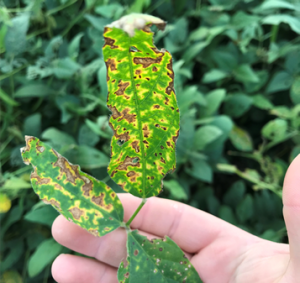Cool, wet conditions are some of the most conducive for soybean disease, but LG Seeds Agronomist Tim Beninga says each weather scenario comes with disease risk. “Whatever Mother Nature delivers, don’t be caught off guard,” he cautions.
Know what you have
“Many soybean diseases overwinter in the soil, so you can have issues even with a good rotation,” says Corey Prosser, an LG Seeds agronomist. Therefore, it’s important to keep good records on fields’ disease histories.
Scouting and soil testing are critical to identifying threats. Beninga says farmers should scout fields throughout the year and encourages them to “take a good look at fields midsummer. From there, continue scouting fields every couple of weeks.”
Common threats include phytophthora, SDS and SCN
Phytophthora root rot is a common soybean threat for both Beninga’s North Dakota farmers and Prosser’s Ohio farmers. “Phytophthora is a warmer-soil disease, which is why we don’t see it come through until later in the season,” Beninga explains. “Phytophthora follows soybean plants down the row, so you’ll see three or four plants in a row that have died.”
The best way to manage Phytophthora is to rotate crops and pick a variety with good resistance, according to Beninga. He details, “The Rps 3a, Rps 1c and Rps 3a/1c stack genes provide the best genetic resistance to the races of Phytophthora we are currently combatting.” Field tolerance is also important. “There are some varieties with no resistance genes that do well because they have good field tolerance,” Beninga explains.
Another common disease that is especially prominent this year in Ohio is sudden death syndrome (SDS), which causes leaves to die from the top down. Because SDS infects the plant early, Prosser says “farmers need to protect themselves upfront with a higher-end seed treatment like Saltro.”
“The other issue we’re running into that’s often categorized as a disease is soybean cyst nematode (SCN),” Beninga says. “There’s a fair amount of it in the Red River Valley, and we’re on watch for it in western North Dakota.
“We know SCN is out there, and we know not everybody is testing for it, so it’s better to plant a variety that has nematode protection,” Beninga says. LG Seeds even offers varieties with the Peking source of resistance, giving farmers options for tackling SCN.
“If you have a history of SDS or SCN or coarse sandy soils where those problems can be more prevalent, select a variety that protects against them and spend the money to upgrade to that Saltro seed treatment,” Prosser advises.

Don’t forget about white mold
White mold (Sclerotinia stem rot) is another disease for farmers to keep in mind, especially those to the north. “We don’t have it that often, but when we do, it can be devastating. White mold affects soybean quality and can cause yield loss,” Prosser explains.
It’s more prevalent in warm, wet years when soybeans have dense canopies. “If you have those conditions and have had issues in the past, you need to be on watch and consider applying a fungicide proactively,” Beninga says.
“You could have white mold in the field 10 years ago, and if the weather conditions are right at the time of infection, you can get it again. The spores are still out there,” Prosser explains.
“If you’ve had this disease, get a soybean with some white mold resistance and rotate to some other crop for a year or two,” Beninga recommends. “And keep track of infected fields. It will likely come back the next time you plant soybeans.”
Seed considerations for riskier disease scenarios
When choosing soybean varieties for early planting, Prosser says farmers should look for:
Good Phytophthora field tolerance. A study by The Ohio State University showed having a resistant gene alone won’t provide enough protection since there are so many races of the disease.
Strong emergence and vigor.
The agronomists note fertilizer prices have some farmers considering back-to-back soybeans, despite the elevated disease risk. “If you plant soybeans on soybeans, make sure you’re using a good seed treatment and varieties that have resistance to disease,” Beninga says. Rotating varieties can also lower those disease odds, Prosser adds.


